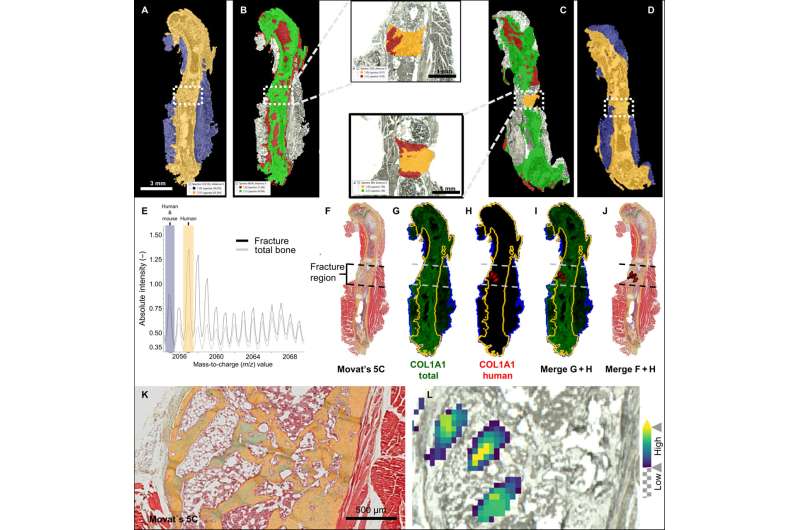This article has been reviewed according to Science X's editorial process and policies. Editors have highlighted the following attributes while ensuring the content's credibility:
fact-checked
peer-reviewed publication
proofread
Using bone marrow precursor cells instead of transplantation to regenerate bone

Bone is the second most commonly transplanted tissue after blood, with about two million bone transplants performed worldwide each year—but often with only moderate therapeutic success. Cell-based therapies could provide an alternative approach to transplantation.
Together with colleagues from Paracelsus Medical Private University (PMU) Salzburg, researchers at the Berlin Institute of Health at Charité (BIH) have now demonstrated that human progenitor cells can regenerate large bone defects and form new mineralized tissue. The researchers have published the findings from their work in the journal Science Translational Medicine.
Although most bone fractures heal completely without scarring, particularly large bone defects caused by severe trauma, infection or tumor surgery often do not heal naturally and require bone transplantation. Bone is the second most commonly transplanted tissue after blood, with about two million bone transplants performed worldwide each year.
However, the availability of grafts is limited and their regenerative capacity is often low. Cell-based therapies offer a promising alternative. Tissue engineered in vitro from progenitor cells such as multipotent stromal cells (MSCs) could replace standard bone graft treatments.
Together with colleagues from Paracelsus Medical Private University (PMU) Salzburg, researchers at the Berlin Institute of Health at Charité (BIH) have now shown that this method works. A crucial factor is that these stromal cells can be obtained from various tissues, such as adipose tissue, skin tissue and bone marrow.
Stromal cell origin plays a key role in regenerative capacity
Multipotent stromal cells (MSCs) are the progenitor cells in various connective tissues that can differentiate into different cell types like fat, cartilage and bone cells. However, contrary to previous assumptions, the source of stromal cells has a decisive impact on their bone regeneration potential. Unlike cells from white adipose tissue, the umbilical cord or skin tissue, only MSCs from bone marrow have the ability to form functional cartilage.
This is due to a so-called epigenetic signature that determines which genes can be accessed during cell differentiation and in which order they are activated.
"This hypertrophic cartilage produced in vitro is an important intermediate for the formation of mineralized bone tissue. We were able to show that transplantation of vital human cartilage disks into mice with large (non-healing) bone defects leads to complete healing," says Dr. Geissler, a group leader at the BIH Center for Regenerative Therapies who is one of the study's senior authors.
"In the animal, the transplanted human cells in the cartilage disks also form the original bone tissue, which is replaced by mouse-derived cells only at the end of complete healing."
New epigenetic mechanism regulates bone healing
In their study, the researchers describe a novel epigenetic mechanism that not only underlies the stromal cells' regenerative potential but also regulates bone healing. This involves a complex network of so-called enhancers—amplifiers of gene expression—in the cells' DNA. This enhancer network is particularly accessible and active in these cells, thus determining the course and success of tissue regeneration. The researchers call this network the "enhancer landscape."
"Our study makes an important contribution to the selection of suitable cells for effective treatment of difficult-to-heal bone fractures. The knowledge gained here about such tissue-specific enhancer signatures may also contribute to the improvement of other cell-based therapies," says Prof. Dirk Strunk, director of the Institute of Experimental and Clinical Cell Therapy at PMU Salzburg and co-senior author of the study.
The path to clinical trials
Further development steps are necessary to translate this new approach into a reliable therapeutic option for large bone defects in orthopedics and trauma surgery. For instance, the researchers led by Sven Geissler and Dirk Strunk now want to conduct tests to see how cartilage disks can be produced automatically from stromal cells and whether exogenous donor cells are also suitable for the therapy.
Patients would otherwise have to wait up to five weeks after having their own cells harvested before the cartilage disks could be produced and implanted. However, there is ample cause for optimism, given the test results achieved so far.
More information: Sarah Hochmann et al, The enhancer landscape predetermines the skeletal regeneration capacity of stromal cells, Science Translational Medicine (2023). DOI: 10.1126/scitranslmed.abm7477




















